Featured Application
Transfer case of hybrid vehicle.
Abstract
The internal–external composite meshing mechanism should be the best way to improve the transmission performance of a silent chain drive, but there is no internal–external composite meshing Hy-Vo chain under the classical design approach. In this research, by building the Hy-Vo chain meshing system, the difference between the meshing of the chain–sprocket and the meshing of the rack–gear is deeply analyzed. By rigidifying the external meshing Hy-Vo chain as a rack, the fluctuation range of the pitch line of the external meshing Hy-Vo chain is analyzed. Based on the relations between the actual chain pitch line and the rigid chain pitch line, the design method for the internal meshing profile of the internal–external composite meshing Hy-Vo chain is deduced, the necessary conditions are obtained, and the meshing characteristics are analyzed. By conducting comparative multi-body dynamics experiments, the results prove that the design method of the internal–external composite meshing Hy-Vo chain proposed in this study is effective and feasible. The results also show that the description of the internal–external composite meshing in the classical meshing theory is not completely correct. In fact, the internal–external composite meshing mechanism cannot reduce the meshing impact of the Hy-Vo chain system and can only improve the system polygon action, the meshing performance, and the transmission stability.
1. Introduction
A Hy-Vo chain is a type of silent chain with rocker pin joints. Benefiting from the construction of the rocker pin joint, the Hy-Vo chain can not only carry a higher torque, but also has a lower system polygon action [1,2]. Therefore, the Hy-Vo chain is extensively applied to areas of heavy loads and high speeds, such as the transfer case in hybrid vehicles. The previous studies have already proved that the internal–external composite meshing mechanism is the best way to improve the transmission performance of a round pin jointed silent chain system [3]. When an external meshing Hy-Vo chain meshes with a sprocket with the involute profile, because the essence of the external meshing is a kind of positioning, the meshing impact between the chain plate external profiles and the sprocket involute profiles is not avoidable [4]. Supposing that the internal–external composite meshing mechanism exists in the Hy-Vo chain system, as Figure 1 shows, the left internal profile of chain plate 3 will first mesh with the sprocket before the external profiles of chain plate 2 come into contact with the sprocket; thus, the meshing impact can be mitigated. Moreover, the classical meshing theory also holds that the internal meshing profile for the internal–external composite meshing Hy-Vo chain should be a kind of arc with a certain convexity [5]. However, the above analysis is only a kind of hypothesis, and it is just suitable for the round pin jointed silent chain system. Furthermore, whether in engineering or in a laboratory, there is no feasible internal–external composite meshing Hy-Vo chain system [6]. Although an internal–external composite meshing Hy-Vo chain does not exist, as Figure 2 displays, some researchers have found that the transmission performance of the Hy-Vo chain system can be improved if the internal–external composite meshing chain plates can be added to the external meshing Hy-Vo chain, and they named the mixed assembly silent chain as a new type Hy-Vo chain [7]. However, the mixed assembly Hy-Vo chain is not applied on a large scale because of its unstable performance. As a result, studying and analyzing the internal meshing profile and internal–external composite meshing mechanism of the Hy-Vo chain are necessary to perfect the meshing theory of the silent chain.
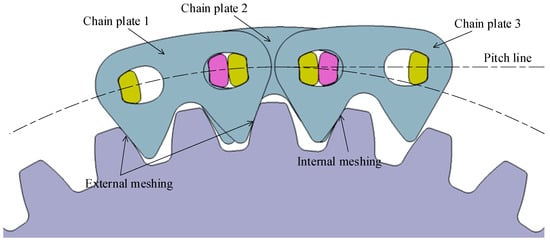
Figure 1.
Internal–external composite meshing of Hy-Vo chain system in classical theory.

Figure 2.
Mixed assembly Hy-Vo chain.
The Hy-Vo chain has been studied for a long time, but its internal–external composite meshing mechanism is rarely studied. By building the rocker pin joint mathematical model, Bucknor N K et al. [8] analyzed the jointed force between the rocker pin and the chain hole and proposed a corresponding optimization scheme. Meng F Z et al. [9,10] developed the classical Hy-Vo chain design system, that is, the chain–sprocket–hob meshing system, proposed the appropriate meshing condition between the circular hole Hy-Vo chain and involute sprocket, and pointed out that the internal–external composite meshing Hy-Vo chain should be existed. Feng Z M et al. [11] studied the internal–external composite meshing mechanism of the mixed assembly Hy-Vo chain drive and then analyzed the nonlinear contact between the internal meshing profile of the mixed assembly Hy-Vo chain and the sprocket involute profile. Cheng Y B et al. [12,13] pointed out that the multi-phase drive can improve the performance of the Hy-Vo chain system transmission and proposed the function for the internal meshing profile of the mixed assembly Hy-Vo chain in a dual-phase system. Obviously, the above studies may involve part of the contents of the internal–external composite meshing mechanism of the Hy-Vo chain system, but the achievements are mainly on the basis of the mixed assembly Hy-Vo chain system. Up to now, there has been no general and effective design approach for the internal–external composite meshing Hy-Vo chain, and its meshing characteristics have not been deeply analyzed. Therefore, the design approach and characteristics of the internal–external composite meshing mechanism of the Hy-Vo chain are worthy of deeper study.
Recently, scholars have been more inclined to research the NVH characteristics of round pin jointed silent chain drive systems. Cali M et al. [14] investigated the relations between the meshing angles and the chain transverse vibrations and tensile forces and proved the dynamics performance of a silent chain transmission system could be significantly improved by slightly adjusting the meshing angles. Liu X L et al. [15] proposed a new type of roller chain for a specific conveyor to reduce the operation noise and analyzed its noise characteristics by conducting experiments. Zhang M Y et al. [16] studied the pressure, thickness, and temperature rise for an oil film in the contact area between the round pin and the chain hole and developed the model from the perspective of stable-state thermal elastohydrodynamic lubrication by using Ree–Eyring fluid. Pan M et al. [17] studied the noise performance of the silent chain drive in cab motorcycles by analyzing the order and the time frequency and analyzed the noise mechanism and the main problems causing noise. Wang S K et al. [18] investigated the fatigue life distribution of silent chain based on the fatigue reliability of a specific silent chain product CL04T-9 and established the relations between the fatigue life and the load level. Lates M T et al. [19,20] analyzed the frictional characteristics between a material named PA46 polyamide and the roller chain and silent chain, obtaining the effects of velocity, tension force, chain pitch, and temperature on the frictional losses of the chain system. Velicu R [21] analyzed the influence of rotational speed on friction losses with temperature in a silent chain drive system. Obviously, if the design approach and meshing characteristics of the internal–external composite meshing Hy-Vo chain can be obtained, the NVH characteristics of the silent chain drive system will be further enhanced by the achievements of the above research.
In this research, we proposed the design approach and the meshing characteristics for the internal–external composite meshing Hy-Vo chain, which cannot be obtained by using the classical meshing theory. Firstly, we built the Hy-Vo chain meshing system and deeply analyzed the difference between the meshing of the chain–sprocket and the meshing of gears. Secondly, by rigidifying the external meshing Hy-Vo chain as a rack, we analyzed the fluctuation range of the pitch line of the external meshing Hy-Vo chain. Based on the relationship between the actual chain pitch line and the rigid chain pitch line, we deduced the function of the internal meshing profile for the internal–external composite meshing Hy-Vo chain system and analyzed its meshing characteristics. Thirdly, we conducted comparative multi-body dynamics experiments. The results show that the design approach of the internal–external composite meshing Hy-Vo chain proposed in this study is effective and feasible, and the internal–external composite meshing characteristics in the classical meshing theory are not completely correct. Compared with the existing Hy-Vo chain types, as for the internal–external composite meshing Hy-Vo chain designed by the new method proposed in this study, the system polygon action, the system meshing performance, and the system transmission stability can all be significantly improved, thus making Hy-Vo chain applicable to the transmission field with more stringent working conditions. At the same time, there is no obvious evidence to show that the internal–external composite meshing mechanism can reduce meshing impacts.
2. Basic Design
2.1. Basic Parameters
Because the internal–external composite meshing Hy-Vo chain is nonexistent, we use mixed assembly Hy-Vo chain plates to exhibit the basic parameters and the difference between the external meshing chain plate and the internal–external composite meshing chain plate. Figure 3a represents the basic parameters of the external meshing Hy-Vo chain plate, and the specific meanings of the parameters are listed in Table 1.

Figure 3.
Parameters of the mixed assembly Hy-Vo chain: (a) external meshing chain plate; (b) internal–external meshing chain plate.

Table 1.
Basic parameters of external meshing Hy-Vo chain.
As for the internal–external composite meshing chain plate in the mixed assembly Hy-Vo chain design system, S2(x2O2y2) is the reference coordinate system to design the internal meshing profile, the curvature center in S2(x2O2y2) is Oρ(xρ, yρ), the radius of the internal meshing profile is rρ, and the value of the convexity is δ. It should be noted that, according to the existing literature, there is no effective function to design the internal meshing profile of the internal–external compound chain plate of the mixed assembly Hy-Vo chain, and the existing data about the internal meshing profile are all from the testing experiences.
The variable pitch characteristic is an important property of the Hy-Vo chain [4]. If there is an angle between two chain plates, the actual chain pitch will be changed, and the value of the equivalent pitch will not be equal to the theoretical pitch p anymore. Figure 4 displays a Hy-Vo chain plate at the rotating state; supposing that the angle between the middle chain plate and the left-side chain plate and that between the middle chain plate and the right-side chain plate are both equal to 2θ, the equivalent pitch should satisfy [22], as follows:
At this time, the equivalent apothem will also be changed, and it should satisfy [22] as follows:
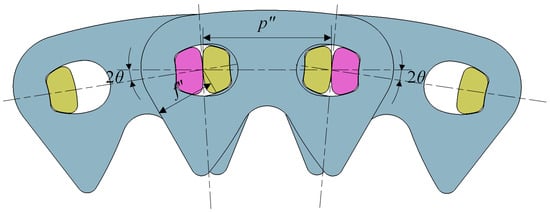
Figure 4.
Hy-Vo chain at the rotating state.
2.2. Meshing Parameters
In the silent chain meshing research area, the chain–sprocket–hob meshing system is always used to analyze the external meshing relations between the chain and the sprocket, as Figure 5 shows. The solid red line denotes the profile of the hob; the hob pitch is p2, and the hob half-tooth angle is α2. The meshing parameters of the Hy-Vo chain and sprocket are listed in Table 2 [22].
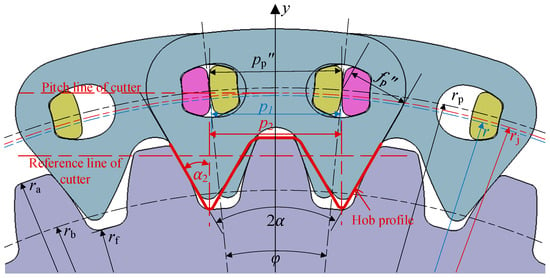
Figure 5.
Meshing system of Hy-Vo chain.

Table 2.
Meshing parameters of Hy-Vo chain system.
In addition to these meshing parameters, there is another important parameter that should be discussed, which is the radius of the sprocket pitch circle rj. In previous studies, the meaning of rj is the pitch circle on the sprocket when the Hy-Vo chain is meshing with it [4]. In this study, we hold that when a chain meshes with a sprocket, there is no pitch circle on the sprocket. The essence of the pitch circle is the set of instantaneous centers when the meshing happens between two gears. If a chain meshes with a sprocket, the set of instantaneous centers on the sprocket should be a kind of polygon that is the inevitable result of the system polygon action. Hence, we believe the meaning of rj should be the radius of the sprocket pitch circle when the hob meshes with it. The function of rj is as follows:
3. Internal Meshing Profile
3.1. Instantaneous Meshing Condition
When there is only an external meshing mechanism for the Hy-Vo chain, the meshing between the chain and the sprocket is instantaneous. In Figure 6, the origin of the absolute coordinate system S(xOy) coincides with the rotation center of the sprocket. S2(x2O2y2) is the reference coordinate system to design the internal meshing profile of the internal–external composite meshing Hy-Vo chain plate. The sprocket rotates anticlockwise at velocity ω, and the sprocket is symmetrical along the y-axis. In this case, chain plate 1 is positioned on the sprocket, chain plate 3 is straightened horizontally, and chain plate 2 meshes with the sprocket while it is also horizontally straightened. Supposing that the right-side external meshing profile of chain plate 2 is T0-T0, the relative sprocket tooth involute profile is Γ0, the relative rotation angle of involute Γ0 on the base circle of the sprocket from the y-axis to its practical position is θ, the corresponding angle of the space width of the sprocket on the base circle is φb. For the above parameters, the following is posed:

Figure 6.
Meshing between the external meshing Hy-Vo chain and the involute sprocket.
At this time, based on the meshing theory, the distance between the chain pitch line and the sprocket rotation center is the shortest. If we suppose the value of this distance is sjmin, we have the following:
According to the meshing relations in Figure 6, the function of line T0-T0 in S2(x2O2y2) is as follows:
Based on the variable pitch characteristic of the Hy-Vo chain, the coordinates of O2 in S(xOy) are (p/2, pp″cot(φ/2)). When plugging the coordinates of O2 and Equation (1) into Equation (6), we can yield the function of line T0-T0 in S(xOy) as follows:
Thus, the function of the tangent line of involute Γ0 in S(xOy) is as follows:
where Φ is the rolling angle on the involute, and it is a variate.
Because line T0-T0 also tangents to involute Γ0, line T0-T0 is the tangent line of involute Γ0. Based on Equations (7) and (8), we can obtain the following:
The solution of Equation (9) is as follows:
If the sprocket pitch p1 is equal to the theoretical chain pitch p, and the sprocket pressure angle α1 is equal to the half angle of chain plate tooth profile α, Equation (10) will be simplified as follows:
3.2. Continuous Meshing Condition
If we rigidify the external meshing Hy-Vo chain into a rigid body, the chain can be regarded as a rack, and the sprocket can be regarded as a short addendum gear. At this time, the meshing of the rigid Hy-Vo chain and the involute sprocket will be the same as the gear meshing, and the meshing is continuous, as Figure 7 shows. The distance between the pitch line of the rigid Hy-Vo chain and the rotation center of the sprocket is sj. According to the gear meshing theory, if the sprocket rotates angle β anticlockwise from its initial position, the rigid Hy-Vo chain will horizontally move βrj to the left. It should be noted that rj is the radius of the sprocket pitch circle when the Hy-Vo chain can be regarded as a rack. In this case, based on Equation (3), the value of rj is as follows:
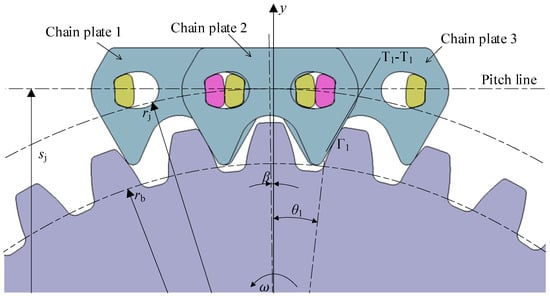
Figure 7.
Meshing of the rigid Hy-Vo chain and the involute sprocket.
Similarly, we suppose that the right-side external meshing profile of chain plate 2 is T1-T1, the relative sprocket tooth involute profile is Γ1, and the relative rotation angle of involute Γ1 on the base circle of the sprocket from the y-axis to its practical position is θ1. According to the relations in Figure 7, the function of line T1-T1 in S(xOy) is as follows:
The tangent line of involute Γ1 is as follows:
Because the rigid Hy-Vo chain can properly mesh with the sprocket, involute Γ1 coincides with line T1-T1:
If p1 = p and α1 = α, combined with Equation (12), the solution of Equation (15) is as follows:
Based on Equations (11) and (16), when θ = θ1, we obtain the following:
Equation (17) means that if the distance between the pitch line of the rigid chain and the sprocket rotation center sj is made to always equal to sjmin, the rigid chain will mesh with the sprocket continuously.
3.3. Proper Internal Meshing Profile
In actuality, the Hy-Vo chain cannot be a rigid body as a rack, and the distance between the chain pitch line and the sprocket rotation center sj will change with the change in the sprocket rotation angle if the sprocket rotates from its initial position. As Figure 8 demonstrates, when the pitch of chain plate 2 is fully within the sprocket positioning circle, sj will be at its maximum:
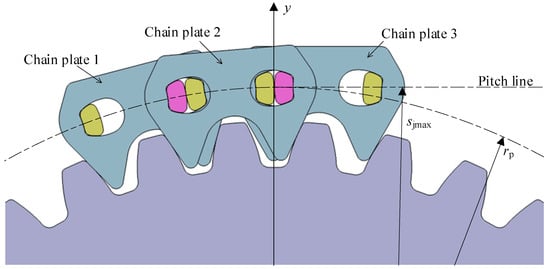
Figure 8.
Meshing state when the chain pitch line is furthest from the sprocket rotation center.
Equations (5), (17) and (18) mean that if there is only an external meshing mechanism for the Hy-Vo chain, the distance between the chain pitch line and the sprocket rotation center sj will fluctuate from sjmin to sjmax. The fluctuation of sj shows that the meshing between the external meshing Hy-Vo chain and the sprocket is totally different from the meshing between the rack and the short addendum gear, and the fluctuation of sj is the real cause of the system polygon action.
From the above analysis, if we let the internal meshing profile of the Hy-Vo chain coincide with the profile of the rigid Hy-Vo chain, the Hy-Vo chain would continuously mesh with the sprocket; this would be the internal–external composite meshing Hy-Vo chain. In this case, the internal meshing profile of the internal–external meshing Hy-Vo chain should be a straight line; according to Equations (5), (17) and (18), the value of the convexity of the internal meshing profile should satisfy the following:
As a result, when p1 = p and α1 = α, the internal meshing profile under the internal–external composite meshing mechanism exists in the Hy-Vo chain transmission system. Figure 9 displays the design scheme of the internal–external composite meshing Hy-Vo chain; the shape of the internal meshing profile is a straight line, and the convexity of the internal meshing profile should satisfy Equation (19). Therefore, we call p1 = p and α1 = α necessary conditions for the existence of the internal–external composite meshing Hy-Vo chain.
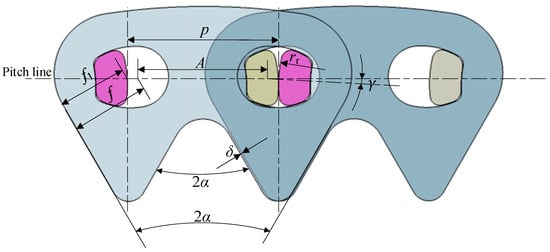
Figure 9.
Design scheme of the internal–external composite meshing Hy-Vo chain.
As we can see from Equation (19) and Figure 9, the internal meshing profile of the internal–external composite meshing Hy-Vo chain is related to the sprocket tooth number. When the tooth number of the drive sprocket is not equal to that of the driven sprocket, we can obtain two or more internal meshing profiles. Therefore, based on the mathematical characteristic of Equation (19), we can guess that if the tooth number of the drive sprocket is near that of the driven sprocket, the corresponding internal meshing profiles should be very similar. Moreover, we can also guess that if the drive ratio of the system is not equal to one, the internal–external composite meshing mechanism may increase the meshing impacts between the chain plates and the sprocket, because there are two appropriate internal meshing profiles in theory.
4. Meshing Characteristics
Figure 10 shows the ideal state of the internal–external composite meshing between the chain plate and the sprocket. In this case, the distance between the left pitch point of the chain plate and the y-axis is supposed to be xp, and the distance between the pitch line of the actual chain and the sprocket rotation center should satisfy sjmax = rp. Under the influence of the convexity of the internal meshing profile, the distance between the left pitch point and the left internal meshing profile is f1 + δ. Supposing that the meshing line of the chain and sprocket is M-M, according to the meshing theory, line M-M tangents to the base circle of the sprocket and passes through the intersection point between the y-axis and the pitch circle of the sprocket. If the internal meshing point between the chain plate and the sprocket is M1, point M1 must be on meshing line M-M.
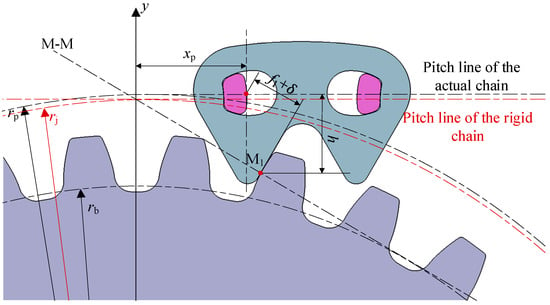
Figure 10.
The ideal state of the internal–external composite meshing between chain plate and sprocket.
Supposing that the distance between point M1 and the actual chain pitch line is h, we obtain the following:
When xp = p, the internal meshing profile of the chain plate begins to mesh with the sprocket involute tooth profile. At this time, the distance between point M1 and the pitch line of the actual chain is at maximum, the maximum value is as follows:
Based on the periodic motion characteristics of the chain, when xp = 0, the meshing between the internal meshing profile and the involute tooth profile must be finished. At this time, the distance between point M1 and the actual chain pitch line is at a minimum, which is
In the practical meshing process, as Figure 11 shows, when xp = 0, the internal meshing profile of the chain plate is already out of contact with the sprocket involute profile; that is, the meshing point M1 lies on the extending line of the internal meshing profile of the chain plate. This is because, compared with the normal silent chain, the hole of the Hy-Vo chain plate is much bigger than that of the normal silent chain plate. To increase the strength of the plate, the Hy-Vo chain equivalent apothem f1 has to be bigger than the normal silent chain standard apothem f. Based on the silent chain meshing theory, if the apothem is greater, the tooth width of the sprocket will be greater, and the tooth shape of the sprocket will be smaller. Because the tooth shape of the sprocket is smaller, the meshing area in the tooth is smaller, and the meshing point is out of the meshing earlier than the theoretical end time. Therefore, in this research, we hold that the internal–external composite meshing between the Hy-Vo chain and sprocket is continuous but incomplete. It should be pointed out that, as for the meshing between the rigid chain and the sprocket, the meshing is continuous and complete because there is another meshing line that is symmetric with line M-M on the y-axis. In conclusion, because the internal–external composite meshing of the Hy-Vo chain is continuous but incomplete, its effect on reducing the polygon action and the meshing impact is limited.
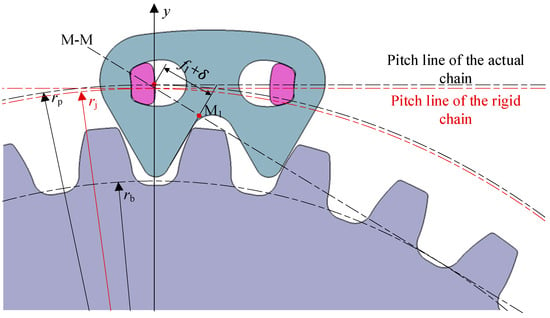
Figure 11.
The practical internal–external composite meshing process between chain plate and sprocket.
5. Multi-Body Dynamics Experiments
5.1. Setting and Calculating
Considering the Hy-Vo chain is a kind of flexible connecting mechanism that consists of a large number of chain plates and pins, the theoretical transmission performance of the Hy-Vo chain system can only be verified by the CAE software [23]. Moreover, the actual Hy-Vo chain is significantly affected by manufacturing errors and assembly errors, and it is difficult to simulate these errors by setting the simulation parameters in the CAE software. Therefore, the multi-body dynamics simulation results can only be used to verify the correctness of the design method, but cannot represent the experiment results under actual conditions. It should be pointed out that the transmission performance mentioned in this paper mainly refers to the Hy-Vo chain meshing transmission performance and has nothing to do with NVH characteristics and wear resistance characteristics.
In this study, we set three groups to simulate and analyze: the external meshing Hy-Vo chain system, the mixed assembly Hy-Vo chain system, and the internal–external composite meshing Hy-Vo chain system, respectively, as shown in Table 3. To obtain the effect of the different meshing mechanisms on the system transmission performance, the basic parameters of these three groups are the same except for the parameters of the internal meshing profile.

Table 3.
Groups setting for simulation.
The basic parameters of these three groups come from an example of widespread use [4,9,11,22]. In this example, the chain pitch is p = 9.525 mm, the hole pitch is A = 8.16 mm, the basic apothem is f = 5 mm, the positioning offsetting angle is γ = 3.8°, the contact radius of the rocker pin is rr = 7.4 mm, the tooth number of the drive sprocket is z1 = 35, the tooth number of the driven sprocket is z2 = 37, and the chain link number is n = 84.
As for the mixed assembly Hy-Vo chain system, the specific setting in Table 3 is mainly derived from the previous studies. These studies have proved that the transmission performance of the system will be the best if the Hy-Vo chain is composed of 44 external meshing chain plates and 40 internal meshing chain plates. Moreover, in this case, the curvature center of the internal meshing profile in S2(x2O2y2) is (11.938 mm, 3.380 mm), the radius rρ is 16.647 mm, and the convexity δ is 0.21 mm [6].
As for the internal–external composite meshing Hy-Vo chain system, according to the design approach introduced in this paper, the internal meshing profile of the internal–external composite meshing Hy-Vo chain should be a straight line. According to the equations of Table 2, we can obtain that the equivalent pitch when the chain is positioned on the drive sprocket is pp1″ = 9.5584 mm, and the equivalent pitch when the chain is positioned on the driven sprocket is pp2″ = 9.5597 mm. When taking the drive sprocket as the basis, according to Equation (19), the convexity of the internal meshing profile is δ1 = 0.1073 mm. Similarly, we can also obtain the convexity of the internal meshing profile based on the driven sprocket, which is δ2 = 0.1015 mm. Because δ1 ≈ δ2, we think the value of the actual convexity should be selected from the range [0.10 mm, 0.11 mm]. In this research, we let the value of the convexity of the internal meshing profile be 0.108 mm.
In this paper, we use the CAE software RecurDyn V9R3 to simulate these three groups; the multi-body dynamics model is shown in Figure 12. In this model, the origin O of the absolute coordinate system S(xOy) is fixed on the drive sprocket rotation center O1. The driven sprocket rotation center O2 is on the x-axis, and the initial system center distance is Sd. When the system is running, under the action of preload F = 800 N, the driven sprocket rotation center O2 will fluctuate horizontally. The simulation time is 0.8 s, and the simulation step is 200. The range of the drive sprocket speed is [1000 rpm, 6500 rpm], and the interval is 500 rpm.
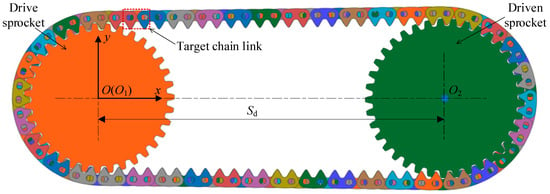
Figure 12.
Multi-body dynamics model in CAE software.
5.2. System Center Distance Fluctuation Analysis
Under the conventional design approach, the maximum fluctuation difference of system center distance is the only index to evaluate the meshing performance of the Hy-Vo chain transmission system, and it is the maximum fluctuation displacement of the driven sprocket rotation center O2 [12,13]. Supposing that the maximum center distance between the drive sprocket and the driven sprocket is Sdmax, the minimum center distance is Sdmin, the maximum fluctuation difference of system center distance is as follows:
Under the classical silent chain meshing theory, if the value of Δf is lesser, the system polygon action will be lesser, and the system meshing performance will be better, too [4].
Figure 13a–l display the simulation results about the system center distance fluctuations of the three groups. We take the calculation process of the maximum fluctuation difference of system center distance when the speed of the drive sprocket is at 1000 rpm as an example. In Figure 13a, as for the external meshing Hy-Vo chain system, when time is equal to 0.673 s, the value of Sdmax is 228.702 mm. When time is equal to 0.226 s, the value of Sdmin is 228.685 mm. Based on Equation (23), we can yield the value of the maximum fluctuation difference of 228.702 − 228.685 = 0.017 mm. As for the mixed assembly Hy-Vo chain system, the maximum value of Sd is reached at 228.688 mm when the time is 0.680 s, and its minimum value is reached at 228.671 mm when the time is 0.226 s. Therefore, the value of Δf is 228.688 − 228.671 = 0.017 mm. As for the internal–external composite meshing Hy-Vo chain system, the value of Sdmax is 228.694 mm when the time is 0.775 s, and the value of Sdmin is 228.683 mm when the time is 0.317 s, so Δf should be 228.694 − 228.683 = 0.011 mm.
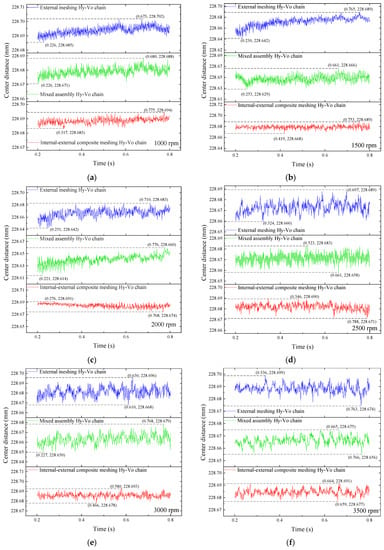
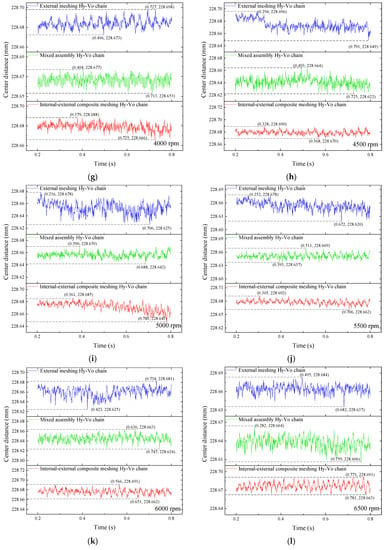
Figure 13.
System center distance fluctuation curves: (a) 1000 rpm; (b) 1500 rpm; (c) 2000 rpm; (d) 2500 rpm; (e) 3000 rpm; (f) 3500 rpm; (g) 4000 rpm; (h) 4500 rpm; (i) 5000 rpm; (j) 5500 rpm; (k) 6000 rpm; and (l) 6500 rpm.
When the value of Δf of the external meshing Hy-Vo chain system when the speed is at 1000 rpm is the benchmark, the maximum fluctuation difference of system center distances for the mixed assembly Hy-Vo chain system is the same as that of the external meshing Hy-Vo chain system, and that of the internal–external composite meshing Hy-Vo chain system is decreased by (0.017 − 0.011)/0.017 = 35.29%. In other words, by using the internal–external composite meshing mechanism, the meshing performance of the Hy-Vo chain system can be improved by 35.29% when the speed is at 1000 rpm.
By using the same method, based on the simulation results of Figure 13, we can easily obtain all values of the maximum fluctuation difference of system center distances for these three groups at all speeds and the meshing performance improving rates of the different meshing mechanism chain systems at all speeds, as Figure 14 shows.
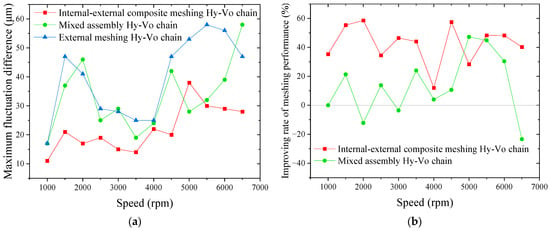
Figure 14.
Analysis based on the maximum fluctuation difference: (a) maximum fluctuation differences; (b) improving rate of meshing performance.
Based on Figure 14a, we know that the system meshing performance can be enhanced to be the best by the internal–external composite meshing mechanism except for when the speed is at 5000 rpm. According to Figure 14b, the average improving rate of meshing performance of the internal–external composite meshing mechanism Hy-Vo chain system reached 42.38%, and that of the mixed assembly Hy-Vo chain is only 13.08%. Therefore, we can obtain the conclusion that the design approach of the internal meshing profile of the internal–external composite meshing Hy-Vo chain proposed in this paper is correct, and the meshing performance of the Hy-Vo chain system can be significantly enhanced by the internal–external composite meshing mechanism.
It can also be obtained from Figure 14 that, from the perspective of the average improving rate, although the meshing performance can also be enhanced by the mixed assembly Hy-Vo chain, the improving performance is uncertain. When the speeds are at 2000 rpm, 3000 rpm, and 6500 rpm, the meshing performance of the mixed assembly Hy-Vo chain system is worsened instead. Therefore, we think the classical design method for the internal meshing profile of the mixed assembly Hy-Vo chain is not proper.
In this paper, we hold that only considering the maximum fluctuation difference of system center distances is not enough, because the fluctuation curves are not always uniform in the simulation time, as Figure 13 shows. Therefore, the standard deviations of fluctuation at different speeds for these three groups should also be calculated to evaluate the transmission stability. The standard deviation of fluctuation is calculated by the following:
where i is the serial number of the simulation step.
Based on Equation (24), the standard deviations of fluctuations and the improving rates of transmission stability for these three groups at different speeds can be obtained, as demonstrated in Figure 15.
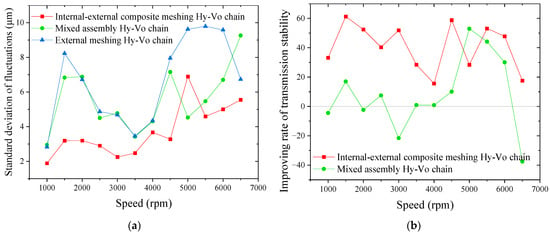
Figure 15.
Analysis based on the standard deviation of the fluctuations: (a) standard deviation of fluctuation; (b) improving rate of transmission stability.
It can be obtained from Figure 15 that the transmission stability of the internal–external composite meshing Hy-Vo chain system is the best, and the average improving rate is reached at 40.73%. In this case, the average improving rate of transmission stability for the mixed assembly Hy-Vo chain system is only 8.12%. Furthermore, under some speeds, the transmission stability of the mixed assembly Hy-Vo chain system may be worsened instead. Therefore, we can conclude that the transmission stability of the Hy-Vo chain system can be markedly improved by using the internal–external composite meshing mechanism, and the design and analysis of the internal meshing profile proposed in this paper are certified to be effective.
5.3. Contact Analysis
In this paper, we use the contact force between the target chain link and the drive sprocket to roughly represent the meshing force between the Hy-Vo chain and the sprockets. As Figure 16 demonstrates, the contact forces appear periodically with the simulation time, and the meshing impacts occur during a period of time at the beginning and end of meshing. This coincides with the time of the contact and separation between the chain link and the sprocket tooth. To analyze the effects of the meshing mechanisms on the meshing impacts under different speeds, we extract the values of the maximum meshing impacts and the values of the average meshing impacts of the three groups at different speeds from Figure 16, as Figure 17 displays.
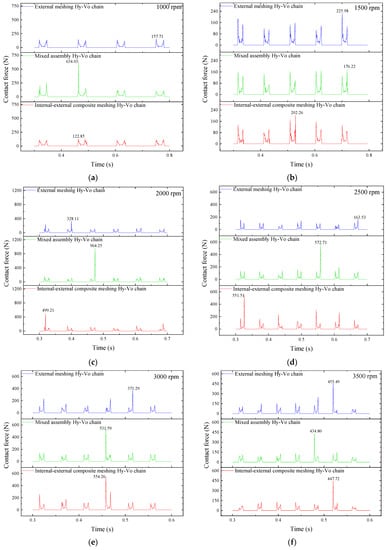
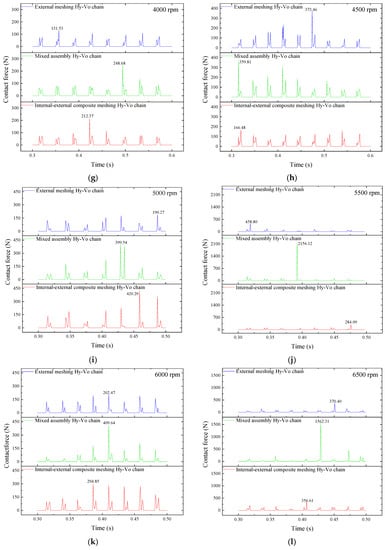
Figure 16.
Meshing force between the target chain link and the drive sprocket: (a) 1000 rpm; (b) 1500 rpm; (c) 2000 rpm; (d) 2500 rpm; (e) 3000 rpm; (f) 3500 rpm; (g) 4000 rpm; (h) 4500 rpm; (i) 5000 rpm; (j) 5500 rpm; (k) 6000 rpm; and (l) 6500 rpm.
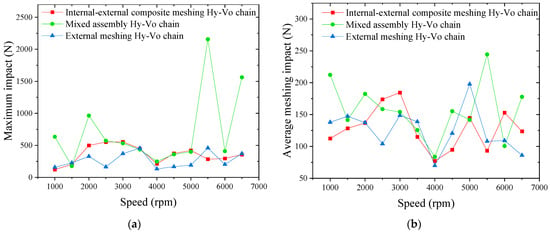
Figure 17.
Meshing impacts: (a) maximum impact curve; (b) average impact curve.
We know from Figure 17a that the maximum meshing impact of the external meshing Hy-Vo chain system at most speeds is the smallest, and that of the mixed assembly Hy-Vo chain system at most speeds is the greatest. From Figure 17b, we can know that, at the speeds of 1000 rpm, 1500 rpm, 3500 rpm, 4500 rpm, and 5500 rpm, the average meshing impact of the internal–external composite meshing Hy-Vo chain system is the smallest. At the speeds of 2500 rpm, 3000 rpm, 4000 rpm, 6000 rpm, and 6500 rpm, the average meshing impact of the external meshing Hy-Vo chain system is the smallest. When the speed is equal to 6000 rpm, the average meshing impact of the mixed assembly is the smallest. As a result, there are no sufficient data to support that the internal–external composite meshing mechanism can effectively mitigate the meshing impact between the Hy-Vo chain and the sprockets.
To further obtain the effect degree of the internal–external composite meshing mechanism on the reduction in the meshing impact, we take the meshing impact of the external meshing Hy-Vo chain system as the benchmark and calculate the decrease rates of the other two chain systems at all speeds, as Figure 18 demonstrates.
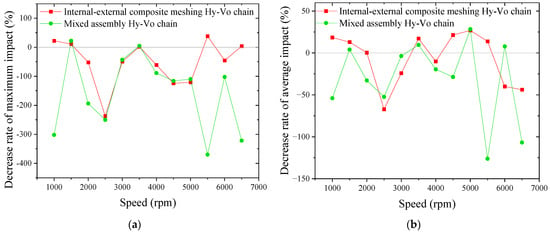
Figure 18.
Decrease rate of meshing impacts: (a) decrease rate of maximum impact; (b) decrease rate of average impact.
As Figure 18 displays, whether for the maximum meshing impact or the average meshing impact, the performance of meshing impact at most speeds will not be improved by using the internal–external composite meshing Hy-Vo chain or the mixed assembly Hy-Vo chain, but will instead be worsened by using them. Especially for the mixed assembly Hy-Vo chain system, the decrease rate of maximum impact can be as low as −369.95%, and the decrease rate of average impact can be as low as −126.20%. This means that, if using the mixed assembly Hy-Vo chain, the maximum meshing impact will be increased by up to 369.95%, and the average meshing impact will be increased by up to 126.20%. Based on the values in Figure 18, we can easily obtain that the mean decrease rates of maximum impact for the internal–external composite meshing Hy-Vo chain system and the mixed assembly Hy-Vo chain system are −51.24% and −156.00%, respectively, and the mean decrease rates of average impact for them are −6.19% and −31.18%, respectively. Therefore, on the one hand, the classical design approach to the internal meshing profile of the mixed assembly Hy-Vo chain is false. On the other hand, the meshing impact between the Hy-Vo chain and the sprockets cannot be reduced by using the internal–external composite meshing mechanism. It should be pointed out that there are no differences between the experiment results and the analysis results in Section 3.3.
5.4. Rotation Velocity of Driven Sprocket Analysis
In classical theory, the system polygon action and the system meshing performance are consistent, so the system polygon action is also verified by testing the maximum fluctuation difference of the system center distance [12,13]. However, in this paper, we hold that the most direct expression of the system polygon action is the fluctuations of the rotation velocity of the driven sprocket. If the fluctuation extent of the rotation velocity of the driven sprocket is smaller, the system polygon action will be smaller.
Taking the calculation of the fluctuation extent of the driven sprocket velocity at 1000 rpm as an example, based on Figure 19a, the maximum value of the driven sprocket velocity of the external meshing Hy-Vo chain system is 100.004 rad/s, and the minimum value of that is 98.090 rad/s; thus, the velocity fluctuation extent is 100.004 − 98.090 = 1.914 rad/s. The maximum value of the driven sprocket velocity of the mixed assembly Hy-Vo chain system is 99.854 rad/s, and the minimum value is 97.997 rad/s; thus, the velocity fluctuation extent is 99.854 − 97.997 = 1.857 rad/s. The upper limit of the driven sprocket of the internal–external composite meshing Hy-Vo chain is 99.840 rad/s, and the lower limit is 98.194 rad/s, so the velocity fluctuation extent is 99.840 − 98.194 = 1.646 rad/s.
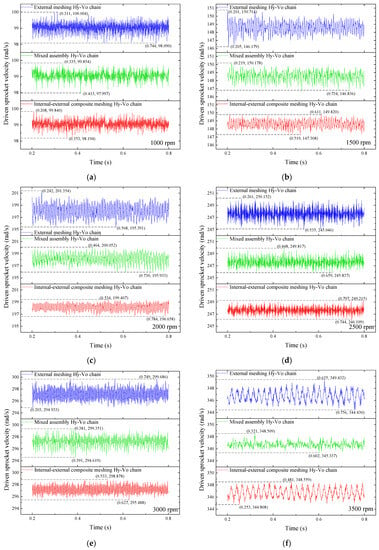
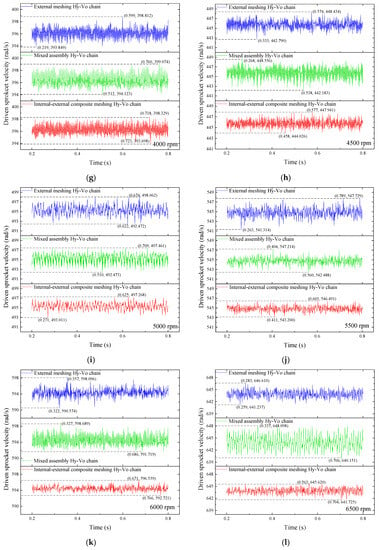
Figure 19.
Rotation velocity fluctuation curves of driven sprocket: (a) 1000 rpm; (b) 1500 rpm; (c) 2000 rpm; (d) 2500 rpm; (e) 3000 rpm; (f) 3500 rpm; (g) 4000 rpm; (h) 4500 rpm; (i) 5000 rpm; (j) 5500 rpm; (k) 6000 rpm; and (l) 6500 rpm.
Compared with the external meshing Hy-Vo chain system, the velocity fluctuation extent of the mixed assembly Hy-Vo chain system is reduced by (1.914 − 1.857)/1.914 = 2.97%, and that of the internal–external composite meshing Hy-Vo chain system is reduced by (1.914 − 1.646)/1.914 = 14.00%. It means that the polygon action in the internal–external composite meshing Hy-Vo chain system is the smallest when the speed is at 1000 rpm. By using the same method, we can obtain the velocity fluctuation extents of the driven sprocket at all speeds, and we can obtain the improving rates of polygon action for the internal–external composite meshing Hy-Vo chain system and mixed assembly Hy-Vo chain system relative to the external meshing Hy-Vo chain system at all speeds, as Figure 20 demonstrates.
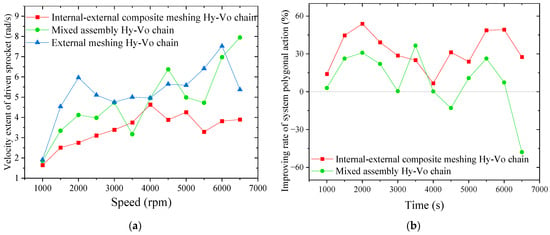
Figure 20.
Analysis based on the driven sprocket velocity: (a) velocity extent of driven sprocket; (b) improving rate of polygon action.
Based on Figure 20a, as for the internal–external composite meshing Hy-Vo chain system, the velocity extents of the driven sprocket, except for 3500 rpm, are the smallest. As for the mixed assembly Hy-Vo chain system, the velocity extents of the driven sprocket at most speeds, except for 4500 rpm and 6500 rpm, are lesser than that of the external meshing Hy-Vo chain. Focusing on Figure 20b, when taking the external meshing Hy-Vo chain as the benchmark, the improving rate of polygon action of the internal–external composite meshing Hy-Vo chain system is much bigger than that of the mixed assembly Hy-Vo chain system at most speeds, except for 3500 rpm. Moreover, the average improving rate of polygon action for the internal–external composite meshing Hy-Vo chain system reached 32.72%, but that of the mixed assembly Hy-Vo chain system is only 8.60%. Based on the calculation results, we can obtain that the internal–external composite meshing Hy-Vo chain can effectively reduce the system polygon action, and the effectiveness of the internal meshing profile design proposed in this research is certified to be reliable. Even though the tooth shape of the sprocket in the Hy-Vo chain system is too small to have a complete internal meshing period, the Hy-Vo chain system polygon action can still be reduced further by the internal–external composite meshing mechanism.
Moreover, the results also show that the polygon action of the Hy-Vo chain system is not always consistent with its meshing performance. For example, when the speed is at 2000 rpm, the polygon action of the mixed assembly Hy-Vo chain system is improved by 30.92%; based on the classical theory, the meshing performance and the transmission stability should also be improved to nearly the same level. However, based on Figure 14b and Figure 15b, the meshing performance of the mixed assembly Hy-Vo chain system is worsened by 12.20% instead, and the transmission stability of that is worsened by 2.37% instead. As a result, the system polygon action is not always consistent with its meshing performance, and the system polygon action cannot be evaluated by testing the maximum fluctuation difference of system center distances.
6. Conclusions
- p1 = p and α1 = α are the necessary conditions for the existence of the internal–external composite meshing Hy-Vo chain. The proper internal meshing profile of the internal–external composite meshing Hy-Vo chain should be a straight line, and its convexity should satisfy Equation (19). Based on the dynamics simulation results, taking the external meshing Hy-Vo chain system as the benchmark, for the internal–external composite meshing Hy-Vo chain system, the meshing performance is improved by an average of 42.38%, the transmission stability is improved by an average of 40.73%, and the polygon action is improved by an average of 32.72%. For the mixed assembly Hy-Vo chain system, the meshing performance, the transmission stability, and the polygon action are only improved by an average of 13.08%, 8.12%, and 8.60%, respectively;
- The mixed assembly Hy-Vo chain cannot stably enhance the system meshing performance, transmission stability, and polygon action. According to the dynamics simulation results, compared with the external meshing Hy-Vo chain system, the system meshing performance, transmission stability, and polygon action of the mixed assembly Hy-Vo chain system can only be improved at some special speeds. At other speeds, the system meshing performance, transmission stability, and polygon action for the mixed assembly Hy-Vo chain system will become worse. In the worst case, the system meshing performance is reduced by 23.40%, the system transmission stability is worsened by 37.57%, and the system polygon action is worsened by 47.91% instead. Therefore, the proper internal meshing profile of the mixed assembly Hy-Vo chain is not an arc, and the relative design approach is false;
- The meshing between the internal–external composite meshing Hy-Vo chain and the involute sprocket is continuous but incomplete; its effect on reducing the polygon action and the transmission performance is limited. The main reason for that is because the tooth shape of the involute sprocket in the Hy-Vo chain transmission system is significantly smaller than that in the round pin jointed silent chain transmission system;
- The classical meshing theory about the internal–external composite meshing characteristics of the Hy-Vo chain is not completely correct. Under the classical meshing theory, the internal–external composite meshing mechanism should enhance the system meshing performance, transmission stability, and polygon action, as well as the meshing impact between the chain and the sprocket. However, based on the dynamics simulation results in this study, the maximum meshing impact of the internal–external composite meshing Hy-Vo chain system is increased by an average of 51.24%, and the average meshing impact is increased by an average of 6.19% instead. Therefore, we know that using the internal–external composite meshing mechanism can only enhance the system meshing performance, transmission stability, and polygon action but cannot improve the performance of the meshing impact;
- The system polygon action is not always consistent with the system meshing performance and transmission stability, and the polygon action of the Hy-Vo chain system cannot be evaluated by testing the maximum fluctuation difference of system center distance. In this research, the experiment results show that the system polygon action has the possibility to be improved when the system meshing performance and the system transmission stability are worsened.
Due to the limited research time and test cycle, some characteristics of the internal–external composite meshing mechanism of the Hy-Vo chain still need to be further studied, such as the influence of the meshing mechanism on the fatigue life and wear resistance of the chain, the effect of the imperfect meshing on the system noise, etc. We firmly believe that, with the improvement of the meshing theory, the internal–external composite meshing Hy-Vo chain can be applied to the transmission field with more stringent working conditions.
Author Contributions
Conceptualization, L.A. and Y.C.; methodology, L.A.; formal analysis, L.A. and J.L.; resources, Y.C.; data curation, L.A. and X.G.; writing—original draft preparation, L.A. and J.L.; writing—review and editing, Y.Y. and X.G.; supervision, L.A.; funding acquisition, Y.C. All authors have read and agreed to the published version of the manuscript.
Funding
This research is supported by The National Natural Science Foundation of China (No. 51775222) and the Science and Technology Development Project of Jilin Province in China (No. 20200401136GX).
Institutional Review Board Statement
Not applicable.
Informed Consent Statement
Not applicable.
Data Availability Statement
Not applicable.
Conflicts of Interest
The authors declare no conflict of interest.
References
- Matsuno, K.; Fukuda, S.; Horie, H.; Iwasaki, Y.; Funamoto, T. Rocker Joint Silent Chain. U.S. Patent US 2002/0072444 A1, 13 June 2002. [Google Scholar]
- Avramidis, S.A.; Ledvina, T.J. Variable Pitch Silent Chain. U.S. Patent 54530059, 26 September 1995. [Google Scholar]
- Xi, J.X.; Feng, Z.M.; Wang, G.Q.; Guo, H.T. Kinetic and Dynamic Characteristics Analysis of Timing Chain System for Diesel Engine. Appl. Mech. Mater. 2014, 602–605, 398–403. [Google Scholar] [CrossRef]
- Meng, F.Z. Meshing Theory of Silent Chain, 2nd ed.; China Machine Press: Beijing, China, 2014; p. 14. ISBN 978-7-111-47598-9. (In Chinese) [Google Scholar]
- Liu, Q.Q. Meshing Analysis of Rocker-Pin Jointed Silent Chain. Ph.D. Thesis, National Cheng Kung University, Tainan, China, 2004. [Google Scholar]
- Qu, S.P. Study of Multi-Variation Design Method and Fatigue Reliability Test of the New Type Hy-Vo Silent Chain. Ph.D. Thesis, Jilin University, Changchun, China, 2013. [Google Scholar]
- Li, Q.H. Meshing Analysis and Design of New Hy-Vo Silent Chain. Ph.D. Thesis, Jilin University, Changchun, China, 2007. [Google Scholar]
- Bucknor, N.K.; Freudenstein, F. Kinematic and Static Force Analysis of Rocker-Pin Jointed Silent Chain with Involute Sprocket. Trans. ASME J. Mech. Des. 1994, 116, 842–848. [Google Scholar] [CrossRef]
- Meng, F.Z.; Liu, X.; Xu, S. Meshing analysis and design of rotundity-datum-aperture Hy-Vo silent chain. Proc. Inst. Mech. Eng. Part C J. Mech. Eng. Sci. 2008, 222, 1297–1303. [Google Scholar] [CrossRef]
- Meng, F.Z.; Feng, Z.M.; Chu, Y.X. Meshing theory and design method of new silent chain and sprocket. Chin. J. Mech. Eng. 2016, 19, 425–427. [Google Scholar] [CrossRef]
- Feng, Z.M.; Meng, F.Z.; Han, F.F. Nolinear Contact Dynamic Analysis of New Hy-Vo Silent Chain Drive. In Proceedings of the Second International Conference on Modelling and Simulation, Manchester, UK, 21–22 May 2009; pp. 427–431. [Google Scholar]
- Cheng, Y.B.; Gao, W.; Liu, H.; Zhang, J.Y.; Li, Y. Research on Design Method of Hy-Vo Silent Chain System for Multi-Phase Transmission. Mech. Based Des. Struct. Mach. 2019, 49, 121–130. [Google Scholar] [CrossRef]
- Cheng, Y.B.; Chen, X.M.; Li, Y.; Li, X.Y.; Chen, L.X.; Niu, J.X. Establishment of Mathematical Model of Internal Tooth Profile Curve and Simulation Based on Dual Phase Silent Chain. Int. J. Veh. Des. 2022, 88, 202–215. [Google Scholar] [CrossRef]
- Cali, M.; Sequenzia, G.; Oliveri, S.M.; Fatuzzo, G. Meshing Angles Evaluation of Silent Chain Drive by Numerical Analysis and Experimental Test. Meccanica 2016, 51, 475–489. [Google Scholar] [CrossRef]
- Liu, X.L.; Wang, W.C.; Sun, W.; Wu, T.S.; Liu, J.J.; Liu, J.F. Design and Experimental Analyse of Low Noise Double-Pitch Silent Chain for Conveyor. Procedia Eng. 2012, 29, 2146–2150. [Google Scholar] [CrossRef]
- Zhang, M.Y.; Wang, J.; Cui, J.L.; Yang, P.R. A Thermal EHL Investigation on Plate-Pin Hinge Pairs in Silent Chains Using a Narrow Finite Line Contact. Ind. Lubr. Tribol. 2020, 72, 1139–1145. [Google Scholar] [CrossRef]
- Pan, M.; Shieh, T. Design Modification for Reducing Silent Chain Annoying Noise. J. Mech. Des. 2002, 124, 822–827. [Google Scholar] [CrossRef]
- Wang, S.K.; Meng, F.Z.; Lan, H. Fatigue Reliability Test Study of Silent Chain. In Proceedings of the 2009 IEEE International Conference on Mechatronics and Automation, Changchun, China, 9–12 August 2009; p. 3304. [Google Scholar]
- Lates, M.T.; Gavrila, C.C. Comparative Study of the Friction Phenomenon in the Contact between the Guide and the Bush and Silent Chain Links. In Proceedings of the 14th International Conference on Tribology, Cluj Napoca, Romania, 19–21 September 2019. [Google Scholar] [CrossRef]
- Lates, M.T.; Velicu, R.; Jurj, L. Influence of Pitch and Exploitation on the Frictional Behaviour of the Silent Chains. Proc. Inst. Mech. Eng. Part D J. Automob. Eng. 2020, 234, 2079–2085. [Google Scholar] [CrossRef]
- Velicu, R. Oil Temperature Influence on Friction Losses in Silent Chains. In Proceedings of the 14th International Conference on Tribology, Cluj Napoca, Romania, 19–21 September 2019. [Google Scholar] [CrossRef]
- An, L.C.; Cheng, Y.B.; Li, J.B.; Xu, W.L. Meshing Evaluation Method for Rocker-Pin Jointed Silent Chain Transmission System Based on the Multi-Factor Coupling Characteristic. Proc. Inst. Mech. Eng. Part C J. Mech. Eng. Sci. 2023; early access. [Google Scholar] [CrossRef]
- Grischgl, M.; Reich, F.M.; Abeltshauser, R.; Eder, M.; Antretter, T. New Approach for the Simulation of Chain Drive Dynamics with Consideration of the Elastic Environment. Proc. Inst. Mech. Eng. Part K J. Multi-Body Dyn. 2017, 231, 103–120. [Google Scholar] [CrossRef]
Disclaimer/Publisher’s Note: The statements, opinions and data contained in all publications are solely those of the individual author(s) and contributor(s) and not of MDPI and/or the editor(s). MDPI and/or the editor(s) disclaim responsibility for any injury to people or property resulting from any ideas, methods, instructions or products referred to in the content. |
© 2023 by the authors. Licensee MDPI, Basel, Switzerland. This article is an open access article distributed under the terms and conditions of the Creative Commons Attribution (CC BY) license (https://creativecommons.org/licenses/by/4.0/).